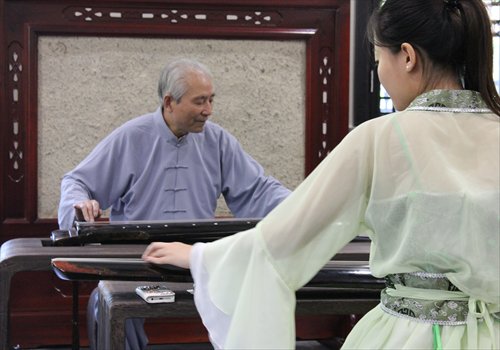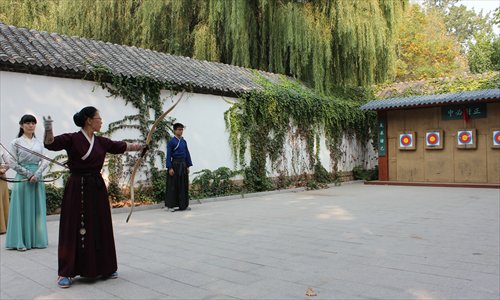

A student learns to play guqin, a traditional Chinese stringed instrument, with her teacher. Photo: Li Jingjing/GT

An archery student shoots at a target on the archery range at the Nishan Academy in Shandong Province. Photo: Li Jingjing/GT
Along the beautiful shores of Daming Lake in Jinan, Shandong Province, lie several buildings built following the style of ancient Chinese architecture. As you approach the compound, the musical sounds of guqin, a traditional Chinese stringed instrument, can be heard coming from inside, while people wearing traditional Han ethnic styled clothing may pass you on your way.
These buildings make up the campus for the newly built Nishan Academy, adjacent to the Shandong Provincial Public Library. Focusing on the teaching of ancient Chinese culture, it looks to imitate the academies of old that once existed in China before the modern era.
Referred to as shuyuan in Chinese, academies such as this were independent educational organizations that can be traced back to the Tang Dynasty (618-907). The original Nishan Academy was built during the Yuan Dynasty (1271-1368) on Nishan Mountain in Shandong.
To emphasize the importance of these academies in modern society, in the preface for The Chinese Academy Dictionary, the late sinologist, writer and linguist Ji Xianlin once wrote, "Shuyuan, that ancient model of running a school, still has meaning in current society. We should take the essence and discard the dross, using this model and adding new content to let it serve for socialism."
A window to the past
Classes teaching guqin, weiqi (Go) and other traditional subjects are held in the halls of the Nishan Academy. In one large yard, students wearing traditional Han ethnic clothing practice archery.
Archery is one of the classic "six arts" - rites, music, archery, charioteering, writing and mathematics - that formed the foundation of an education system that originated in the Zhou Dynasty (1046-221 BC).
In another building, public lectures on "The Four Books (The Great Learning, The Doctrine of the Mean, The Analects of Confucius, and The Works of Mencius) and Five Classics" (The Book of Songs, The Book of History, The Book of Changes, The Book of Rites and The Spring and Autumn Annals), major works in the Confucian canon, are also held.
Although these subjects may seem outdated they are an important part of Chinese tradition. To emphasize the important role in carrying on this tradition, in September of last year, Xu Jialu, former vice-chairman of the Standing Committee of National People's Congress and president of the Nishan Academy, stated that academies such as the Nishan Academy should shoulder the responsibility of promoting traditional Confucian culture by providing an important supplement to modern education.
Yu Xiaofeng, a staff member at the Shandong Provincial library, told the Global Times that they provide lectures for free every weekend, inviting Sinology experts to talk on different topics. Archery, guqin and other classes are also free of charge.
"We are providing a platform for teachers and those interested in traditional Chinese culture," explained Yu.
A model for modern society
Zhao Ping, one of the students at the academy, has been learning Chinese archery for three years. She explained to the Global Times that unlike current bows, traditional Chinese bows are long, large bows that lack any sights for aiming.
"Where the arrow hits doesn't matter, what matters is the process of shooting a bow. It's a process of cultivating one's mind," Zhao said.
She explained that learning archery taught her not to care about how she performs compared with other people, since it's her own state of mind that allows her to make a good shot.
"Ever since I started practicing archery, my friends told me my manner and temperament have changed. I really feel myself changing inside. I reflect on myself everyday with every shot I take. It affects how I socialize with others as well," Zhao said.
While it appears to be just a sport, in practice the skill is more like deep meditation. "Tai Chi, guqin, all these traditions share some similarities, they change a person from the inside," she said.
In order to revive ancient form of educational institution and get people more involved in modern libraries, in May of this year the Culture Department of Shandong Province implemented a new model of public cultural service by establishing small "Nishan Acadamies" in libraries across the province. Months later, this new model continues to attract more people. However, in an interview with the Global Times, Yu admitted that the majority of attendees are retired people who have more time to attend. Children make up another large group, since these academies cooperate with schools to arrange summer camps. Figuring out ways to get young adults and middle-aged people involved has become one of the biggest challenges for the program.
Yan Binggang, the vice president of the Advanced Institute of Confucian Study at Shandong University, told the Global Times of another reason promoting traditional Confucian culture in urban areas can be so difficult. "Due to the Cultural Revolution (1966-76), some older people in cities are prejudiced against Confucius. It's difficult to reverse such an ingrained idea."
Despite these difficulties Zhao is confident of the program's merit, even if most students are senior citizens. "Children learn from others. When older citizens do something, children tend to do the same as well," she said.
Copyright ©1999-2018
Chinanews.com. All rights reserved.
Reproduction in whole or in part without permission is prohibited.